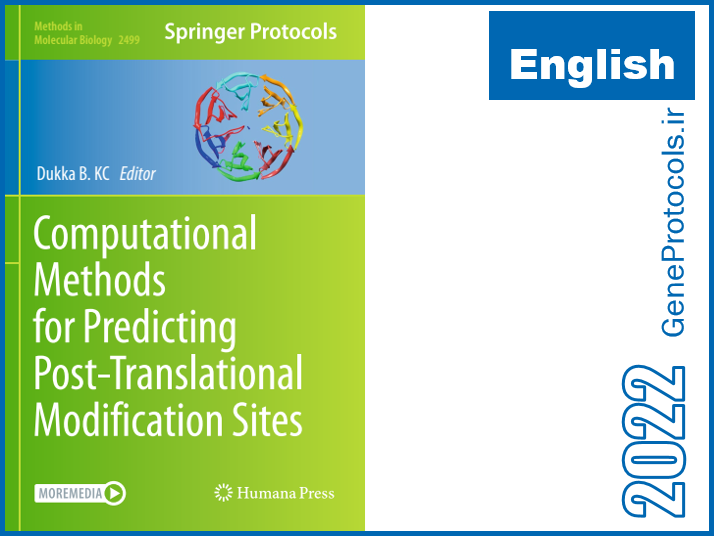-
قابل دانلود از چهارشنبه, ۲۳ فروردين ۱۴۰۲
|
فهرست مطالب: Dedication . . . . . . . . . . . . . . . . . . . . . . . . . . . . . . . . . . . . . . . . . . . . . . . . . . . . . . . . . . . . . . . . . . vPreface . . . . . . . . . . . . . . . . . . . . . . . . . . . . . . . . . . . . . . . . . . . . . . . . . . . . . . . . . . . . . . . . . . . . . vii Acknowledgments. . . . . . . . . . . . . . . . . . . . . . . . . . . . . . . . . . . . . . . . . . . . . . . . . . . . . . . . . . . . . xi Contributors. . . . . . . . . . . . . . . . . . . . . . . . . . . . . . . . . . . . . . . . . . . . . . . . . . . . . . . . . . . . . . . . . xv 1 Maximizing Depth of PTM Coverage: Generating Robust MS Datasets for Computational Prediction Modeling . . . . . . . . . . . . . . . . . . . . . . . . . . . 1 Anthony A. Iannetta and Leslie M. Hicks 2 PLDMS: Phosphopeptide Library Dephosphorylation Followed by Mass Spectrometry Analysis to Determine the Specificity of Phosphatases for Dephosphorylation Site Sequences . . . . . . . . . . . . . . . . . . . . . . . . 43 Thomas Kokot, Bernhard Hoermann, Dominic Helm, Jeremy E. Chojnacki, Mikhail M. Savitski, and Maja Ko ¨hn 3 FEPS: A Tool for Feature Extraction from Protein Sequence . . . . . . . . . . . . . . . . . 65 Hamid Ismail, Clarence White, Hussam AL-Barakati, Robert H. Newman, and Dukka B. KC 4 A Pretrained ELECTRA Model for Kinase-Specific Phosphorylation Site Prediction. . . . . . . . . . . . . . . . . . . . . . . . . . . . . . . . . . . . . . . . . . . . . . . . . . . . . . . . . . 105 Lei Jiang, Duolin Wang, and Dong Xu 5 iProtGly-SS: A Tool to Accurately Predict Protein Glycation Site Using Structural-Based Features . . . . . . . . . . . . . . . . . . . . . . . . . . . . . . . . . . . . . . 125 Iman Dehzangi, Alok Sharma, and Swakkhar Shatabda 6 Functions of Glycosylation and Related Web Resources for Its Prediction. . . . . . . . . . . . . . . . . . . . . . . . . . . . . . . . . . . . . . . . . . . . . . . . . . . . . . . . . . . 135 Kiyoko F. Aoki-Kinoshita 7 Analysis of Posttranslational Modifications in Arabidopsis Proteins and Metabolic Pathways Using the FAT-PTM Database . . . . . . . . . . . . . 145 Madison N. Blea and Ian S. Wallace 8 Bioinformatic Analyses of Peroxiredoxins and RF-Prx: A Random Forest-Based Predictor and Classifier for Prxs . . . . . . . . . . . . . . . . . . . . 155 Hussam AL-Barakati, Robert H. Newman, Dukka B. KC, and Leslie B. Poole 9 Computational Prediction of N- and O-Linked Glycosylation Sites for Human and Mouse Proteins. . . . . . . . . . . . . . . . . . . . . . . . . . . . . . . . . . . . . . 177 Ghazaleh Taherzadeh, Matthew Campbell, and Yaoqi Zhou 10 iPTMnet RESTful API for Post-translational Modification Network Analysis . . . . . . . . . . . . . . . . . . . . . . . . . . . . . . . . . . . . . . . . . . . . . . . . . . . . . . . 187 Sachin Gavali, Karen E. Ross, Julie Cowart, Chuming Chen, and Cathy H. Wu xiii11 Systematic Characterization of Lysine Post-translational Modification Sites Using MUscADEL. . . . . . . . . . . . . . . . . . . . . . . . . . . . . . . . . . . . . 205 Zhen Chen, Xuhan Liu, Fuyi Li, Chen Li, Tatiana Marquez-Lago Andre´ Leier, Geoffrey I. Webb, Dakang Xu, Tatsuya Akutsu, and Jiangning Song 12 Enhancing the Discovery of Functional Post-Translational Modification Sites with Machine Learning Models – Development, Validation, and Interpretation . . . . . . . . . . . . . . . . . . . . . . . . . . . . . . . . . . . . . . . . . . . . 221 Nolan English and Matthew Torres 13 Exploration of Protein Posttranslational Modification Landscape and Cross Talk with CrossTalkMapper. . . . . . . . . . . . . . . . . . . . . . . . . . . . . . . . . . . . . 261 Arthur Grimaud, Frederik Haugaard Holck, Louise Marie Buur, Rebecca Kirsch, and Veit Schwammle € 14 PTM-X: Prediction of Post-Translational Modification Crosstalk Within and Across Proteins . . . . . . . . . . . . . . . . . . . . . . . . . . . . . . . . . . . . . . . . . . . . . . 275 Yuxuan Li, Yuanhua Huang, and Tingting Li 15 Deep Learning–Based Advances In Protein Posttranslational Modification Site and Protein Cleavage Prediction . . . . . . . . . . . . . . . . . . . . . . . . . . 285 Subash C. Pakhrin, Suresh Pokharel, Hiroto Saigo, and Dukka B. KC Index . . . . . . . . . . . . . . . . . . . . . . . . . . . . . . . . . . . . . . . . . . . . . . . . . . . . . . . . . . . . . . . . . . . . . . 323 مشخصات فایل |
|
| عنوان (Title): | Computational Methods for Predicting Post-Translational Modification Sites |
| نام فایل (File name): | 918-www.GeneProtocols.ir-Computational Methods for Predicting Post-Translational Modification Sites-Humana (2022).pdf |
| عنوان فارسی (Title in Persian): | روشهای محاسباتی برای پیشبینی سایتهای اصلاح پس از ترجمه |
| ایجاد کننده: | Dukka B. KC |
| زبان (Language): | انگلیسی English |
| سال انتشار: | 2022 |
| شابک ISBN: | 1071623168, 9781071623169 |
| نوع سند (Doc. type): | کتاب |
| فرمت (File extention): | |
| حجم فایل (File size): | 9.52 مگابایت |
| تعداد صفحات (Book length in pages): | 337 |
پس از پرداخت، دانلود فایل آغاز می شود
درباره درگاه پرداخت نکست پی بیشتر بدانید
برچسب ها:
2022,
آنالیز,
انگلیسی,
برنامه نویسی,
بیوانفورماتیک,
محاسبات,
مهندسی ژنتیک,
ویرایش ژنوم,
پروتکل ژنتیک,
تمامی درگاه های پرداخت ژنـ پروتکل توسط شرکت دانش بنیان نکست پی پشتیبانی می شود. نکست پی دارای مجوز رسمی پرداختیاری به شماره 1971/ص/98 ، از شرکت شاپرک و بانک مرکزی جمهوری اسلامی ایران و دارای نماد اعتماد در حوزه (متمرکزکنندگان پرداخت) از مرکز توسعه تجارت الکترونیکی وزارت صنعت معدن و تجارت است.




